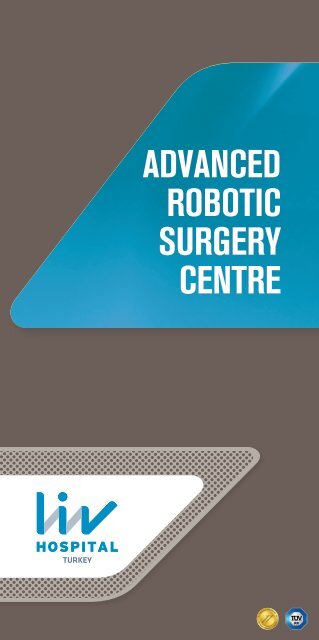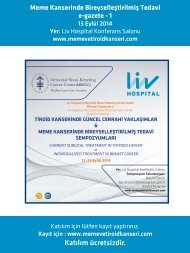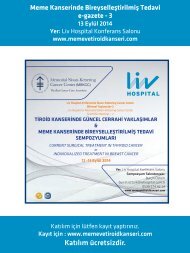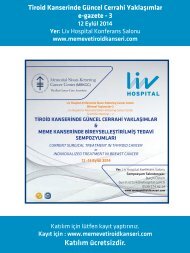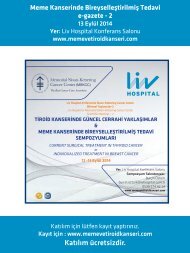ADVANCED ROBOTIC SURGERY CENTRE
You also want an ePaper? Increase the reach of your titles
YUMPU automatically turns print PDFs into web optimized ePapers that Google loves.
<strong>ADVANCED</strong><br />
<strong>ROBOTIC</strong><br />
<strong>SURGERY</strong><br />
<strong>CENTRE</strong><br />
m<br />
cs<br />
cs<br />
cs<br />
9<br />
2<br />
TURKEY
SURGICAL TREATMENTS<br />
The patients are evaluated with multidisciplinary<br />
approach at Liv Hospital Cancer Center. Patientbased<br />
treatment approach is adopted with<br />
individualized cancer treatment for the patients<br />
who are examined by physicians from various<br />
disciplines.<br />
Colorectal Cancers<br />
Preserving life quality of the patient during the therapy<br />
is highly important for our physicians. Minimal invasive<br />
surgical procedures (Laparoscopic and Robotic Surgery),<br />
radiation therapy techniques with high rate of certainty<br />
and chemotherapy designed for providing you high cancer<br />
control and healing opportunity allow you to maintain<br />
your daily life healthy and comfortable as far as possible.<br />
Treatment of colorectal cancer may show variation related<br />
to whether tumor is localized in colon or rectum, or it is<br />
result of a genetic inheritance.
Pancreas Cancer<br />
Most of the pancreas cancers emerge from exocrine<br />
cells present in pancreatic ducts that carry digestive<br />
enzymes to intestines. Majority of these cancers are<br />
called adenocarcinomas that occur in tissues covering<br />
inner surface of pancreas. Early diagnosis of pancreas<br />
cancers with aggressive morphology is crucial. Most<br />
proper treatment method is known as surgery in pancreas<br />
cancer; and multidisciplinary approach increases change of<br />
success at Liv Hospital Cancer Center that provides service<br />
with individualized treatment methods and advanced<br />
technology in pre-operative and post-operative period.<br />
Surgical treatments of the patients can be performed<br />
by laparoscopic and robotic methods. For this reasons,<br />
patients get advantages of less pain, quicker recovery, less<br />
hospitalization and better cosmetic results.<br />
Gall Bladder and Bile Duct Cancers<br />
Bile duct cancer which is more common at old ages<br />
and males is seen mainly in the patients with familial<br />
inflammatory diseases, bile duct stone and bile duct cyst.<br />
Still most effective treatment method is surgery in gall<br />
bladder and bile duct cancers and they can be treated<br />
successfully by using individualized treatment methods<br />
at Liv Hospital Cancer Center that provides service with<br />
advanced technology. Change of success increases with<br />
early diagnosis in this disease concerning a critical region.<br />
Every kind of intervention can be performed for treatment<br />
of hepatitic diseases at Radiology and Gastroenterology<br />
Departments where advanced technological devices are<br />
used. Multidisciplinary approach increases change of<br />
success at Liv Hospital Cancer Center that provides service<br />
with individualized treatment methods and advanced<br />
technology in pre-operative and post-operative period.
Esophageal Cancer<br />
Most of the esophageal tumor is adenocarcinoma of<br />
squamous cell carcinoma. Esophageal cancer that is<br />
generally indicated with swallowing difficulty is diagnosed<br />
with endoscopy. Most effective treatment method is<br />
surgical intervention in esophageal cancers. Procedure<br />
called esophagectomy aims complete removal of the<br />
tumor in order to prevent its re-increment and spread.<br />
Esophagectomy (complete removal of esophagus) is<br />
performed by using open surgical methods or minimal<br />
invasive methods (laparoscopic-robotic). Stomach is<br />
used to form a new tube or new esophagus is form by<br />
using patient’s large intestine. Most proper treatment<br />
method is known as surgery in esophageal cancers; and<br />
multidisciplinary approach increases change of success<br />
at Liv Hospital Cancer Center that provides service with<br />
individualized treatment methods and advanced technology<br />
in pre-operative and post-operative period.<br />
Stomach Cancer<br />
Stomach is a digestive organ where foods are digested and<br />
that is located between esophagus and small intestine.<br />
Stomach cancer emerges from inner surface of the<br />
stomach and can spread through lymph nodes. Endoscopy<br />
is performed to the patients with swallowing difficulty,<br />
anemia, weight loss, abdominal pain complaints and biopsy<br />
is taken from the mass localized inside of stomach. Vascular<br />
structures must be preserved carefully during the surgery,<br />
and lymph nodes must be removed broadly. Disease-free<br />
survival time significantly increases with quality of the<br />
surgery. For this reason, stomach cancer surgery requires<br />
high surgical experience and talent. Most proper treatment<br />
method is known as surgery in stomach cancer cancers;<br />
and multidisciplinary approach increases change of success<br />
at Liv Hospital Cancer Center that provides service with<br />
advanced technology.
Robotic Surgery for Liv Hospital<br />
International Patients<br />
The surgical application of robotic systems is one of the<br />
most exciting and significant technological developments<br />
of this century; its future implications are incalculable. Huge<br />
strides have been made in the field of closed operations<br />
in the past 10 years and the use of robotic systems has<br />
emerged as the principle solution to technical limitations.<br />
With our CyberKnife, Da Vinci and Acrobat Navigator<br />
technology, and a dedicated team of trained and<br />
experienced physicians and specialists, LiV Hospital is<br />
proud to be a regional leader in the field of robotic surgery.<br />
This information has been prepared for our International<br />
Patients in order to provide more detailed knowledge and<br />
perspective about the techniques available to them through<br />
the LiV Hospital International Office. All our international<br />
patients are served by a support structure delivered by a<br />
personal Recovery Specialist; international patients should<br />
contact our International Office with any questions or<br />
comments concerning Robotic Surgery at Liv Hospital.<br />
What is Robotic Surgery?<br />
In the first part of the 21st century, the introduction of the<br />
use of robotic systems in the surgical field is an exciting<br />
and highly significant development. The development of<br />
this kind of system was initially lead by NASA in the 1970’s,<br />
with a view to facilitating the treatment of astronauts in<br />
space by remote control. Based on this concept, a prototype<br />
of the Da Vinci robotic system was first introduced in 1997<br />
and received FDA approval in the year 2000. Since then,<br />
the field of application of robotic systems has expanded<br />
considerably; they are now used in numerous medical<br />
centers in heart surgery, urology, general surgery, thoracic<br />
surgery, child birth and pediatric operations.
What are the advantages of<br />
Robotic Surgery?<br />
In addition to the classic advantages of laparoscopic<br />
surgery, the most significant benefits of robotic surgery are<br />
as follows:<br />
• LESS PAIN: Minimal trauma to the skin and muscle<br />
means much less post-operation pain and discomfort.<br />
• LOWER RISK OF INFECTION: Minimum contact<br />
between the abdominal organs and the air in the<br />
operating theater leads to a significantly lower risk of<br />
infection compared to open surgery.<br />
• SAFER <strong>SURGERY</strong>: 3-D and magnified images provide<br />
better vision and protection of the blood vessels and<br />
nerves. For example, blood loss during surgery is greatly<br />
reduced.<br />
• LESS SCARRING: With 1 – 1.5 cm incisions compared<br />
to 20-25 cm incisions in open surgery, scarring is<br />
minimized.<br />
• FAST RECOVERY: Earlier post-operation mobilization<br />
and oral nutrition leads to the patient’s speedier<br />
recovery.<br />
• REDUCTION OF HOSPITALIZATION PERIODS: Most<br />
patients are discharged 3 or 4 days after surgery.<br />
• A FAST RETURN TO WORK AND DAILY LIFE: Patients<br />
return to normal life more rapidly due to more rapid<br />
recovery and healing.
Which Operations Can Be<br />
Done with Robots?<br />
Although the increasingly widespread use of robotic surgery<br />
over the past decade has been concentrated on urologic<br />
surgery, it is now being ever more widely used in general,<br />
gynecological and heart surgery.<br />
Robotic Urology<br />
The prostate is a gland in the male system that plays a<br />
role in bladder output and semen viscosity. It is composed<br />
of secretive cells and peripheral tissue. Prostate cancer<br />
occurs with the abnormal development of these secretive<br />
cells. Unless diagnosed early, prostate cancer spreads to<br />
peripheral tissues via lymph and blood vessels. The areas<br />
to which it most commonly spreads (metastasis) are the<br />
peripheral lymph nodes and bones. It can also spread to the<br />
lungs, liver and other organs.<br />
There are various methods to treat prostate cancer. The<br />
most effective of these methods is radical prostatectomy.<br />
The 10-year disease-specific survival rate for patients<br />
with well differentiated tumors who have undergone<br />
radical prostatectomy is over 90%. For this reason, radical<br />
prostatectomy is the most preferred of all available<br />
treatment methods. Traditional open radical prostatectomy<br />
surgery is carried out with a large surgical incision. This<br />
means the patient experiences longer hospitalization time,<br />
a prolonged period of post-operation recovery and healing,<br />
exposure to a higher risk of infection and greater scarring.<br />
Robotic prostatectomy procedures that have become more<br />
widespread in recent years are performed with a small<br />
incision and offer the patient a less traumatic<br />
and minimally invasive alternative.
Advantages of Robotic Radical<br />
Prostatectomy<br />
• Less Loss of Blood: In robotic radical prostatectomy<br />
surgery, the abdomen is inflated with gas. This gas<br />
pressure leads to a significant reduction in bleeding.<br />
The gas is discharged from the abdomen at the end of<br />
the operation. Moreover, bleeding can be more clearly<br />
detected and stopped earlier with the use of 3-D high<br />
definition cameras that can magnify the operation area.<br />
There is generally no need for blood transfusions.<br />
• Shorter Hospitalization Periods: Since robotic surgery<br />
involves smaller incisions and much less loss of blood,<br />
patients are discharged from hospital earlier than when<br />
compared with open surgery operations.<br />
• Shorter Catheter Period: Since robotic prostatectomy<br />
surgery enables waterproof stitching together of the<br />
urinary bladder and urinary tract (anastomosis), the<br />
catheter can be removed within 6-7 days.<br />
• Less Pain: Because of the smaller surgical incisions,<br />
patients experience less pain and discomfort compared<br />
to open surgery procedures.<br />
• Better Cancer Control: With the aid of 3-D high<br />
definition images and instruments that can move<br />
in 7 degrees, the prostate tissue can be more clearly<br />
observed during the robotic prostatectomy procedure.<br />
In robotic surgery the prostate apical region can be<br />
seen much more clearly and operated on much more<br />
precisely. As a result, surgical margin positivities are<br />
significantly reduced.<br />
• Better Bladder Control: Bladder control is regained<br />
earlier in robotic prostatectomy patients when<br />
compared to those who have undergone traditional<br />
surgery. Factors that help to achieve earlier bladder<br />
control include better imagery, less bleeding and the<br />
retention of a longer urethra.<br />
• An Earlier Return to Normal Sex Life: Robotic<br />
prostatectomy facilitates the protection of the<br />
neurovascular bundle around the prostate and allows<br />
patients to return to a normal sex life earlier than is the<br />
case with traditional surgery.
Robotic Gynecology<br />
Liv Hospital is at the forefront of remarkable advances in<br />
gynecological oncology, high-risk pregnancy and IVF / PGD<br />
treatments, and expert in all areas of women’s health for<br />
women of all ages, from adolescence on. For some patients,<br />
minimally invasive surgery and Da Vinci robotic surgery may<br />
be an option.<br />
Robotic Oncology<br />
The Liv Hospital Medical Oncology Department aims to<br />
provide patients with the maximum protection while<br />
slowing or preventing the spread of the cancer, leading<br />
to eradication of the cancer with subsequent surgical or<br />
radiation treatment, if required.<br />
In cases of early detection, surgical treatment may be<br />
sufficient. In more advanced cases, (especially if it has<br />
spread to other organs), the treatment protocol may vary.<br />
The treatment will depend on the type of cancer, its<br />
extent and location and also on the individual<br />
requirements of the patient.<br />
Combining the specialty fields of Endocrine<br />
Surgery, Breast Surgery, Surgical<br />
Gastroenterology, Liver and Bile Duct<br />
Surgery, Peripheral Vascular Surgery,<br />
Varicose Vein Disease and Obesity<br />
Surgery in a multidisciplinary<br />
approach that embraces joint<br />
efforts with the department of<br />
Oncology.
Da Vinci Robotic Surgical Systems<br />
As shown in image 1, the Da Vinci system consists of a<br />
robotic tower (comprising binoculars, optic camera and 3<br />
robotic arms), and surgeon’s console giving high definition<br />
3D vision of the operation area and the control area for the<br />
three robotic arms.<br />
As shown in image 2, the binoculars offer 3D vision with<br />
actual field of depth for the control hands (left) through the<br />
binocular optics (right)
Robotic Technology at Liv Hospital<br />
• DA VINCI S SURGICAL SYSTEM<br />
The Da Vinci’s Robotic Surgical System integrates<br />
groundbreaking robotic technology with 3D, high<br />
definition endoscopy. Using this equipment, our<br />
surgeons can perform more complex, minimally<br />
invasive keyhole surgery, including prostatectomies,<br />
gynecological and maxillofacial procedures. For the<br />
majority of patients, this means less pain and blood loss<br />
and a faster recovery period compared to conventional,<br />
open surgery.<br />
• ACROBAT NAVIGATOR<br />
This robotic system enables surgeons to perform<br />
complex hip and knee operations with unique<br />
precision using Global Positioning System (GPS) type<br />
technology. Similar to GPS for mapping travel routes,<br />
the system enables the surgeon to navigate surgical<br />
cuts via wireless trackers and cameras. A model of the<br />
individual’s joint is produced on a computer as guidance<br />
for the surgeon to perform procedures with a fraction of<br />
a degree – improving accuracy with pinpoint precision.
The Age of Robotic Surgery and<br />
MAKOplasty at Liv Hospital<br />
Liv Hospital offers international patients a comprehensive<br />
range of robotic surgery procedures, including an end to<br />
painful knee and hip replacements with state-of-the-art<br />
MAKOplasty<br />
With our CyberKnife, Da Vinci, Acrobat Navigator and now<br />
MAKOplasty surgery carried out by our dedicated team of<br />
experienced physicians and specialists, Liv Hospital is a<br />
regional leader in robotic surgery in a wide range of cases<br />
from cancer to knee replacements.<br />
<strong>ROBOTIC</strong> <strong>SURGERY</strong> - A WORLD OF DIFFERENCE AT<br />
LIV HOSPITAL<br />
• Less Pain<br />
• Lower Risk of Infection<br />
• Safer Surgery and Precision Non-Invasive Cancer<br />
Treatment<br />
• Precision Knee And Hip Replacements With Rapid, Full<br />
Recovery<br />
• Less Scarring<br />
• Fast Recovery<br />
• Reduction of Hospitalization Periods<br />
• A Fast Return to Work And Daily Life Robotic<br />
Technology at Liv Hospital
Robotic technology at Liv Hospital<br />
MAKOPLASTY KNEE AND HIP REPLACEMENT <strong>SURGERY</strong><br />
Liv Hospital surgeons plan partial knee or total hip<br />
replacement using 3D computer imaging. The MAKOplasty<br />
robotic arm system provides visual, auditory, and tactile<br />
control so surgeons cut away only the exact bone planned,<br />
for accurate, less painful, more rapid and successful<br />
outcomes.<br />
DA VINCI’S SURGICAL SYSTEM<br />
Using this equipment, Liv Hospital surgeons can perform<br />
more complex keyhole surgery, including prostatectomies,<br />
gynecological and maxillofacial procedures with less pain<br />
and blood loss, and a faster recovery period.
A Groundbreaking Method of Gastric Bypass<br />
Surgery and the Gold Standard in Obesity Treatment:<br />
The occurrence of obesity is on a continuous upward trend<br />
and has become a very significant public health issue. With<br />
high success rates, obesity and metabolic surgery has<br />
gained in importance and is being used more frequently to<br />
treat diseases associated with obesity such as diabetes and<br />
high blood pressure.<br />
Robotic surgery is regarded as the gold standard in obesity<br />
surgery. Its weight loss credentials are superior to other<br />
techniques. Under this technique, patients lose 80% of<br />
their excess weight and continue to lose weight for a<br />
period of 18-24 months. It also enjoys greater success rates<br />
than conventional methods in terms of its effectiveness<br />
in correcting obesity-related conditions such as diabetes,<br />
high blood pressure and lipid disorders (cholesterol etc.).<br />
Patients’ food intake and absorption levels are effectively<br />
reduced.<br />
PLK-YRD-153/00
Life is Beautiful<br />
TURKEY<br />
www.livclinics.com<br />
international@livclinics.com<br />
facebook.com/livclinics<br />
twitter.com/livclinics<br />
linkedin.com/livclinics<br />
+90 212 999 80 99<br />
+90 530 174 33 72


